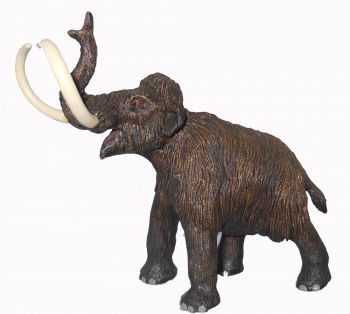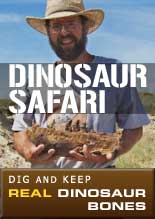
Mammuthus primigenius was the true Woolly Mammoth
Mammoth remains have been found in Europe, Africa, Asia, and North America. They are believed to have originally evolved in North Africa about 4.8 million years ago, during the Pliocene, where bones of Mammuthus africanavus have been found in Chad, Libya, Morocco and Tunisia. Mammuthus subplanifrons, found in South Africa and Kenya, is also believed to be one of the oldest species (about 4 million years ago).
Despite their African ancestry, they are in fact more closely related to the modern Asian Elephant than either of the two African elephants. The common ancestor of both mammoths and Asian elephants split from the line of African elephants about 6 - 7.3 million years ago. The Asian elephants and mammoths diverged about half a million years later (5.5 - 6.3 million years ago).
In due course the African mammoth migrated north to Europe and gave rise to a new species, the southern mammoth (Mammuthus meridionalis). This eventually spread across Europe and Asia and crossed the now-submerged Bering Land Bridge into North America.
Around 700,000 years ago, the warm climate of the time deteriorated markedly and the savannah plains of Europe, Asia and North America gave way to colder and less fertile steppes. The southern mammoth consequently declined, being replaced across most of its territory by the cold-adapted steppe mammoth (Mammuthus trogontherii). This in turn gave rise to the woolly mammoth, Mammuthus primigenius) around 300,000 years ago. Woolly mammoths were better able to cope with the extreme cold of the Ice Ages.
The woollies were a spectacularly successful species; they ranged from Spain to North America and are thought to have existed in huge numbers. The Russian researcher Sergei Zimov estimates that during the last Ice Age, parts of Siberia may have had an average population density of sixty animals per hundred square kilometres - equivalent to African elephants today.
Extinction
Most mammoths died out at the end of the last Ice Age. A definitive explanation for their mass extinction is yet to be agreed upon. However, the small mammoths of Wrangel Island became extinct only around 1700 to 1500 BC.
Whether the general mammoth population died out for climatic reasons or due to overhunting by humans is controversial. Another theory suggests that mammoths may have fallen victim to an infectious disease. A combination of climate change and hunting by humans is probably the most likely explanation for their extinction.
New data derived from studies done on living elephants and reported by the American Institute of Biological Sciences (BioScience, April 2006, Vol. 56 No. 4, pp. 292-298) suggests that though human hunting may not have been the primary cause toward the mammoth's final extinction, human hunting was likely a strong contributing factor. Homo erectus is known to have consumed mammoth meat as early as 1.8 million years ago.
However, the American Institute of Biological Sciences also notes that bones of dead elephants, left on the ground and subsequently trampled by other elephants, tend to bear marks resembling butchery marks, which have previously been misinterpreted as such by archaeologists.
The survival of the dwarf mammoths on Russia's Wrangel Island was due to the fact that the island was very remote, and uninhabited in the early Holocene period. The actual island was not discovered by modern civilization until the 1820s by American whalers. A similar dwarfing occurred with Mammoths on the outer Channel Islands of California, but at an earlier period. Those animals were very likely killed by early Paleo-Native Americans, and habitat loss.
There have been occasional claims that the woolly mammoth is not actually extinct, and that small isolated herds might survive in Siberia.
Size
A full size reconstruction of a mammoth species, the woolly mammoth, at Ipswich Museum, Ipswich, SuffolkIt is a common misconception that mammoths were much larger than modern elephants, an error that has led to "mammoth" being used as an adjective meaning "very big". Certainly, the largest known species, the Imperial Mammoth of California, reached heights of at least 7 meters (20 feet) at the shoulder. Mammoths would probably weigh in the region of 6-8 tons. [1]. However, most species of mammoth were only about as large as a modern Asian Elephant, and fossils of species of dwarf mammoth have been found on the Californian Channel Islands (Mammuthus exilis) and the Mediterranean island of Sardinia (Mammuthus lamarmorae). There was also a race of dwarf woolly mammoths on Wrangel Island, north of Canada, within the Artic Circle.
Based on studies of their close relatives, the modern elephants, mammoths probably had a gestation period of 22 months, resulting in a single calf being born. Their social structure was probably the same as that of African and Asian elephants, with females living in herds headed by a matriach, whilst bulls lived solitary lives or formed loose groups after sexual maturity.
Origins of the name
The name "mammoth" comes via Russian from the Tatar language. It may have its origins in the Tatar word mamma, "earth", alluding to the long-held belief that mammoths lived underground and made burrows. The 17th century traveller Eberhard Ysbrant Ides recorded that the Evenk, Yakut and Ostyak peoples of Siberia believed that the mammoths "continually, or at least by reason of the very hard frosts, mostly live under ground, where they go backwards and forwards." Exposure to the air was enough to kill them, explaining why they were never seen alive.
From Wikipeda
phthalate-free rubber
6 x 5 inches
Item 327
MORE PHOTOS:


Now Over 1,000 Items!
PrehistoricStore.com offers the largest selection of replica fossils and other fossil-related products anywhere in the world!
Download a Full Catalog (3MB PDF)
OVER 260 PAGES OF REPLICAS AND MORE!
